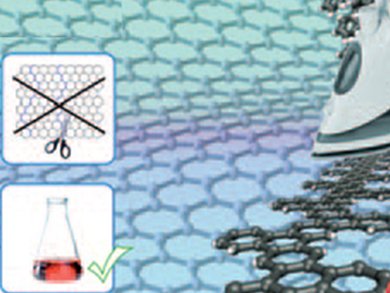Graphene nanoribbons show semiconducting behavior that renders them suitable active materials for electronic devices. A team led by Klaus Müllen, Max Planck Institute in Polymer Research, Germany, has described the bottom-up synthesis of shape-controlled graphene nanoribbons.
Polymeric polyphenylene precursors were prepared by using microwave-assisted Suzuki-polycondensation, and were then converted into the corresponding graphene nanoribbons by a multiple Scholl reaction using FeCl3 (see reaction scheme in figure). The structure of these nanoribbons was confirmed by NMR spectroscopy and MALDI-TOF mass spectrometry, while other precursors showed a red shift of the emission maximum in the UV/Vis and photoluminescence spectroscopy.

Images: (c) Wiley-VCH
- Graphene Nanoribbons by Chemists: Nanometer-Sized, Soluble, and Defect-Free
L. Dössel, L. Gherghel, X. Feng, K. Müllen,
Angew. Chem. Int. Ed. 2011, 50.
DOI: 10.1002/anie.201006593 - L. Dössel, L. Gherghel, X. Feng, K. Müllen,
Angew. Chem. 2011, 123.
DOI: 10.1002/ange.201006593



